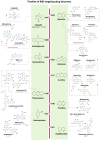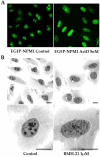Targeting Ribosome Biogenesis in Cancer: Lessons Learned and Way Forward
- PMID: 35565259
- PMCID: PMC9100539
- DOI: 10.3390/cancers14092126
Targeting Ribosome Biogenesis in Cancer: Lessons Learned and Way Forward
Abstract
Rapid growth and unrestrained proliferation is a hallmark of many cancers. To accomplish this, cancer cells re-wire and increase their biosynthetic and metabolic activities, including ribosome biogenesis (RiBi), a complex, highly energy-consuming process. Several chemotherapeutic agents used in the clinic impair this process by interfering with the transcription of ribosomal RNA (rRNA) in the nucleolus through the blockade of RNA polymerase I or by limiting the nucleotide building blocks of RNA, thereby ultimately preventing the synthesis of new ribosomes. Perturbations in RiBi activate nucleolar stress response pathways, including those controlled by p53. While compounds such as actinomycin D and oxaliplatin effectively disrupt RiBi, there is an ongoing effort to improve the specificity further and find new potent RiBi-targeting compounds with improved pharmacological characteristics. A few recently identified inhibitors have also become popular as research tools, facilitating our advances in understanding RiBi. Here we provide a comprehensive overview of the various compounds targeting RiBi, their mechanism of action, and potential use in cancer therapy. We discuss screening strategies, drug repurposing, and common problems with compound specificity and mechanisms of action. Finally, emerging paths to discovery and avenues for the development of potential biomarkers predictive of therapeutic outcomes across cancer subtypes are also presented.
Keywords: RNA polymerase I; cancer; nucleolus; p53; ribosome biogenesis; translation.
Conflict of interest statement
The authors declare that they have no conflicts of interest. The funders had no role in the collection, analyses, or interpretation of data, in the writing of the manuscript, or in the decision to publish the results.
Figures



Similar articles
-
The Effects of Deregulated Ribosomal Biogenesis in Cancer.Biomolecules. 2023 Oct 30;13(11):1593. doi: 10.3390/biom13111593. Biomolecules. 2023. PMID: 38002277 Free PMC article. Review.
-
p53 at the crossroad of DNA replication and ribosome biogenesis stress pathways.Cell Death Differ. 2022 May;29(5):972-982. doi: 10.1038/s41418-022-00999-w. Epub 2022 Apr 20. Cell Death Differ. 2022. PMID: 35444234 Free PMC article. Review.
-
Dysregulated Ribosome Biogenesis Reveals Therapeutic Liabilities in Cancer.Trends Cancer. 2021 Jan;7(1):57-76. doi: 10.1016/j.trecan.2020.08.003. Epub 2020 Sep 15. Trends Cancer. 2021. PMID: 32948502 Review.
-
The homeostatic regulation of ribosome biogenesis.Semin Cell Dev Biol. 2023 Feb 28;136:13-26. doi: 10.1016/j.semcdb.2022.03.043. Epub 2022 Apr 16. Semin Cell Dev Biol. 2023. PMID: 35440410 Free PMC article. Review.
-
Small molecule-mediated disruption of ribosome biogenesis synergizes with FGFR inhibitors to suppress glioma cell growth.Neuro Oncol. 2023 Jun 2;25(6):1058-1072. doi: 10.1093/neuonc/noac286. Neuro Oncol. 2023. PMID: 36583853 Free PMC article.
Cited by
-
Decoding Ribosome Heterogeneity: A New Horizon in Cancer Therapy.Biomedicines. 2024 Jan 11;12(1):155. doi: 10.3390/biomedicines12010155. Biomedicines. 2024. PMID: 38255260 Free PMC article. Review.
-
Chromatin damage generated by DNA intercalators leads to degradation of RNA Polymerase II.Nucleic Acids Res. 2024 May 8;52(8):4151-4166. doi: 10.1093/nar/gkae069. Nucleic Acids Res. 2024. PMID: 38340348 Free PMC article.
-
Crossing boundaries of light microscopy resolution discerns novel assemblies in the nucleolus.Histochem Cell Biol. 2024 Jul;162(1-2):161-183. doi: 10.1007/s00418-024-02297-7. Epub 2024 May 17. Histochem Cell Biol. 2024. PMID: 38758429 Free PMC article.
-
HIV Vpr activates a nucleolar-specific ATR pathway to degrade the nucleolar stress sensor CCDC137.Nucleic Acids Res. 2025 Jun 6;53(11):gkaf531. doi: 10.1093/nar/gkaf531. Nucleic Acids Res. 2025. PMID: 40530693 Free PMC article.
-
The RNA helicase DDX21 activates YAP to promote tumorigenesis and is transcriptionally upregulated by β-catenin in colorectal cancer.Oncogene. 2024 Oct;43(44):3227-3239. doi: 10.1038/s41388-024-03160-8. Epub 2024 Sep 17. Oncogene. 2024. PMID: 39285230 Free PMC article.
References
Publication types
LinkOut - more resources
Full Text Sources
Other Literature Sources
Research Materials
Miscellaneous

